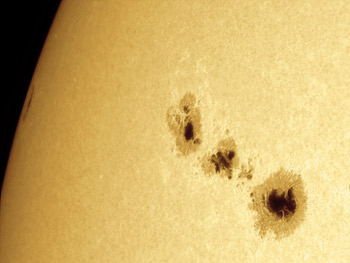On Saturday, September 24, 2011, at 09:40 UT, most of the folks working for NASA were probably asleep. But NASA’s Solar Dynamic Observatory never sleeps: it’s only job is to stare at the Sun, 24 hours a day, every day.
Good thing it does, too, because it caught a pretty decent-sized solar flare erupting from the Sun’s disk at that time:
Isn’t that awesome? Make sure you set the resolution to at least 720p and make it full screen for the full effect.
The flare was technically class X1.9, which is at the low end of the highest category of flare power. It blasted out radiation across the electromagnetic spectrum (this animation shows the Sun in the far-ultraviolet), and probably released at least as much energy as a billion one-megaton bombs.
Good thing we’re 150 million kilometers away. Yegads.
The flickering threw me for a sec, but if you pause the video during the flare, you’ll see it’s due to the flare changing its brightness. The software used to create the animation automatically accounts for total brightness in an image, so when the flare gets bright the overall image brightness gets turned down. The brightness varied pretty rapidly, changing on a time scale of just a few minutes; since the animation is sped up we see it flickering. The entire flaring episode lasts just less than an hour.
The X-shape, streaks, and vertical line you see during the flare are instrument artifacts and aren’t real. They’re like the cross-shaped diffraction spikes you see in bright star images with Hubble.
 The flare came from a sunspot cluster called Active Region 1302; “amateur” astronomer Alan Friedman got a fantastic shot of them just the other day, seen here (click to ensolarnate).
The flare came from a sunspot cluster called Active Region 1302; “amateur” astronomer Alan Friedman got a fantastic shot of them just the other day, seen here (click to ensolarnate).
There are vast energies stored in the magnetic field lines piercing those spots. Those lines get tangled up, and can suddenly snap, releasing that energy as an intense burst of light as well as a blast of subatomic particles (for details on this, read this earlier post on how sunspots make solar flares).
That region is pretty feisty, and the odds of us getting more flares from those spots are pretty good. The Sun’s rotation is currently taking them toward the center of the disk, where a good sized explosion is then directed toward us, and particle waves from the blast can then interact more efficiently with our magnetic field. We may be getting aurorae from them, and if things go well that’s all we’ll get! A big blast can damage satellites, and even put astronauts on the ISS at risk. We on the ground are pretty safe, since the Earth’s air absorbs the radiation – that’s why we have to launch satellites like SDO into space, so they can detect that energy in the first place!
However, a big blast can shake the Earth’s magnetic field, inducing a current in the ground that can actually overload power lines. We can get blackouts from such things, and it’s happened before. This is a real problem that can do millions or even billions of dollars of infrastructure damage (including money in the economy lost during the blackout). I know a lot of solar physicists are concerned about this eventuality, and are trying to get both the power companies and the government to take it seriously. I hope they do. We’re still approaching the peak of the solar cycle sometime in mid-2013 or so, and flares like the one Saturday will most likely be more common.
Credits: NASA/SDO; Alan Friedman
Related posts:
- First earthward-heading solar flare of the cycle
- Solar storm tracked all the way from the Sun to Earth
- Another big solar flare
- Scientists see sunspots forming 60,000 km below the Sun’s surface!